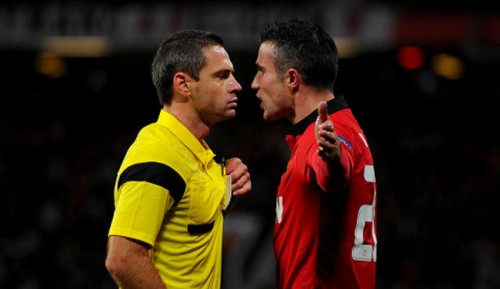In matchday 1’s Champions League match between Manchester United and Bayer Leverkusen at Old Trafford, there were two remarkable situations related to the performance of referee Damir Skomina and his crew of whom one was already discussed and analyzed last week.
 |
| Face2Face: Damir Skomina and Robin van Persie (c) whoateallthepies |
The more interesting but surely less attention-grabbing incident occurred in the 39th minute of play when Skomina and ManU forward Robin van Persie spectacularly argued with each other face to face.
First of all, it should be mentioned that the free-kick given by Skomina was correct. Even though the last foul was none, the Dutch forward held his opponent’s shirt for a while so that a delayed whistle was justified. Then we surely must point out the dissent beginning with van Persie seeking confrontation with the referee by questioning his decision verbally and with sweeping gestures. Referees must be aware that in tough matches the teams' fight for the aspired outcome of the match is so important that anger or tension, that have piled up throughout the game, may easily erupt in one single situation that is actually of minor relevance. Mostly the referees’ calls provide players with the needed target to vent their spleen and to set a sign for team-mates or even opponents. So dissent as one form of conflict is inevitable and natural. Football probably would suffer if those emotive sallies did not exist. Thus dissent claims targeted and pro-active conflict management from the referee, who must act like a psychologist in such occasions. Damir Skomina should have been prepared and, experienced as he is, he naturally has got the required management skills to cope with that. But unfortunately he did not show it in this minute 39.
If the referee and a player confront each other face to face, if their foreheads almost touch, something went wrong. Instead of finding the adequate means to calm down van Persie, who is widely known for his diva-like behaviour on the pitch if things do not develop as he wants, referee Skomina accepted the confrontation with an exaggerated body language and gestures that revealed the referee’s fretted and totally annoyed mood. Both yelled at each other, the referee did so, too. This provoked a reaction from van Persie. One overreaction caused the next overreaction leading to no sporting solution.
Then Skomina sorted out the yellow card and raised it in an overhasty manner. This style of showing the YC did not testify much self-confidence and determination. That became even clearer when Skomina made another annoyed gesture and - having the card still in his hand - waved the player away. At the end, it was the referee who fled from the centre of attention in place of staying firm. The entire occasion sent a bad message to the rest of the players – and also to the crowd. Skomina conveyed the impression of a referee whose authority can be easily undermined and who has no other means to solve conflicts except hiding behind his yellow card. That’s not the kind of player management that should be apparent on the highest level. Skomina definitely can and will improve that. In this case, I missed his typical Skomina-finger-waving that made him succeed in terms of match control in the past.
No comments:
Post a Comment